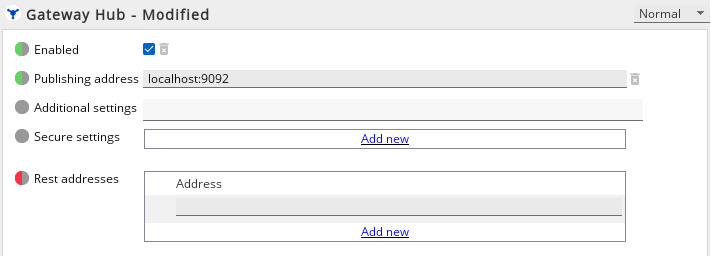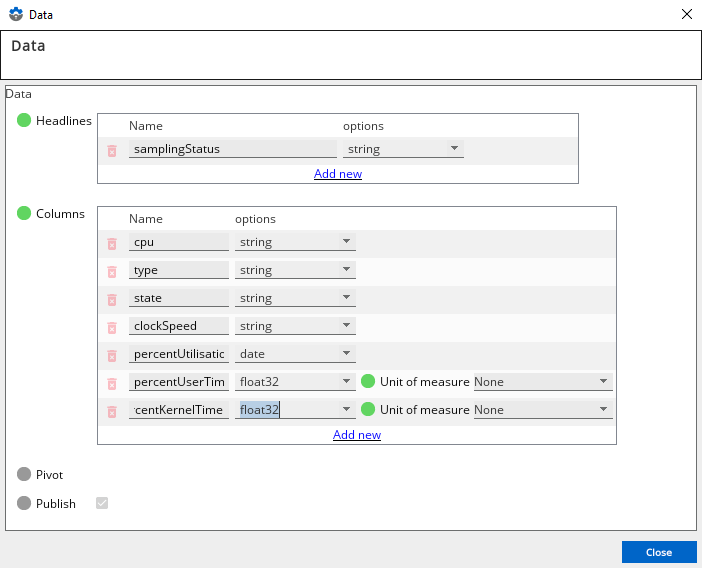If you are currently using version 5.x.x, we advise you to upgrade to the latest version before the EOL date. You can find the latest documentation here.
Gateway Hub Configuration
Overview
This technical reference provides information about the configuration of the Gateway Hub top-level section, and the Publishing tab of a sampler in the GSE.
Note: Beginning in Geneos 4.12, Gateway supports a more efficient communication protocol. This protocol is used when communicating with Gateway Hub 1.4 and later. This protocol reduces the bandwidth and storage required for metrics messages by up to 50% compared to Gateway 4.11 and earlier.
The latest versions of both components are available from the ITRS Downloads.
Anomaly detection and centralised configuration
To use anomaly detection features you must start the Gateway in centrally configured mode. To do this, use the -gateway-hub <REST URL> command line option when starting the Gateway. The URL specified here will take precedence over any value specified in the Gateway Setup Editor.
For more information, see Anomaly Detection and Centralised Gateways User Guide.
Gateway Hub section in GSE
Configuration
The Gateway Hub section of the GSE provides a range of options:

| Setting | Description | Default |
|---|---|---|
| Enabled |
Enables/disables publishing to Gateway Hub. Gateway Hub and Publish to Kafkacan be enabled at the same time. Errors generated by attempting to publish to Gateway Hub do not affect the operation of Publishing. Similarly, errors generated by attempting to publish using Publishing do not affect the operation of Gateway Hub. Note: Gateway Hub publishing is not available from shared Gateways. Instead, you must enable publishing from the source Gateways. Caution: After you have started publishing to Gateway Hub, be aware that temporarily disabling publishing may result in Gateway Hub containing references to obsolete or deleted items. For example, if a managed entity is deleted, the Gateway cannot buffer this information and the Gateway Hub is not notified of the deletion when publishing is resumed. It is recommend that once started you do not disable publishing from the Gateway to Gateway Hub. |
True |
| Publishing Address |
Specifies a comma-separated list of host/port
pairs to use for establishing the connection to Gateway Hub. The adapter makes use of all servers irrespective of which servers are specified here for bootstrapping - this list only impacts the initial hosts used to discover the full set of brokers. Please refer to the description of
Note: The technology used to publish from Gateway to Gateway Hub is internal and may change in the future. |
hub.example.com:9092
|
| Additional settings |
These additional settings control how the adapter is loaded, or are settings interpreted by the adapter itself. Each setting is entered on one line, and each line specifies one key-value pair. Each setting (key) starts with one of two prefixes:
Settings with the prefix
Settings with the prefix
|
|
| Secure Settings |
This section allows settings that cannot be set in cleartext, such as passwords, to be encrypted in the Gateway setup file. This has two fields:
|
|
| REST addresses |
Specifies the https address that is the base URL for the REST endpoints used by Active Console. For more information about Gateway Hub connectivity, see Connectivity in Gateway Hub . In v4.12 Gateways and higher, starting the Gateway with |
https://hub.example.com:8081
|
Note: Starting the Gateway with command line options overrides these settings. See Gateway command line options.
Sampler Publishing tab
Publishing tab configuration
User-defined data schemas are visible in the Publishing tab of a sampler. For more information, see Samplers.
Caution: Gateway Hub will reject metrics from Gateway samplers or dataviews that include the / character in their name.

| Section | Field | Description |
|---|---|---|
| Schemas > Dataviews | Dataview |
Specifies the name of the dataview that the schema applies to. If omitted, the schema applies to the dataview that has the same name as the sampler (the default dataview). |
| Schema |
This has two options:
|
|
| Standardised formatting > Dataviews | Names |
Name of the variable. |
| Variables | Variable definition specifying type and applicability of variable. |
Schema configuration
This screen is accessed through Data... in the Schema > Dataviews section in the Publishing tab of a sampler.
Here you indicate:
- The columns or headlines in the published dataview.
- The data types of the columns and headlines.
- The units of measure for the columns and headlines (if applicable).

| Section | Field | Description | Mandatory | Default |
|---|---|---|---|---|
| Headlines | Name | Name of the headline that appears in the dataview. | ||
| Type |
Data type of the headline that appears in the dataview. The data types include: |
|||
| Unit of measure |
Specifies the units of measure of the data type that appears in the dataview. Only certain data types have specified units of measure. The options for units of measure are outlined in Data schema parameters in Data Schema User Guide. |
|||
| Columns | Name |
Name of the column that appears in the dataview. |
||
| Type |
Data type of the column that appears in the dataview. The data types include: Note: Columns declared as |
|||
| Unit of measure |
Specifies the units of measure of the data type that appears in the dataview. Only certain data types have specified units of measure. The options for units of measure are outlined in Data schema parameters in Data Schema User Guide. |
|||
| Pivot |
This option should only be used for dataviews that display one value per row with values of a variety of types. For example, a Toolkit sampler with a summary dataview containing two columns - Name and Value, and three rows of varying data types - If enabled, the dataview is pivoted so row names become column headings and the heading of the single data column becomes the name of a single data row. |
No | False | |
| Publish | Turns publishing of the dataview on or off. | No | True | |
Restrictions on column names
The Gateway Hub normalisation process uses some names that might generate an invalid internal schema for the corresponding metric series.
To avoid generating an invalid schema:
- Do not attempt to create a schema for a dataview with columns or headlines that have any of the following names:
sampleTime,netprobeTime, anddataviewId. - Do not attempt to create a schema for a dataview with columns or headlines which start with
a_, or includes a repeated underscore__.For example, if a Geneos dataview contains columns or headlines named both
process idandprocess__20_id, or10_year_avganda_10_year_avg, then this generates an invalid internal schema for the corresponding metric series.
Instead you should change the configuration of the sampler, or disable publishing for the dataview.